
High Plains Gardening
The gardening website of the Texas High Plains Region
Last year, 2022, brought 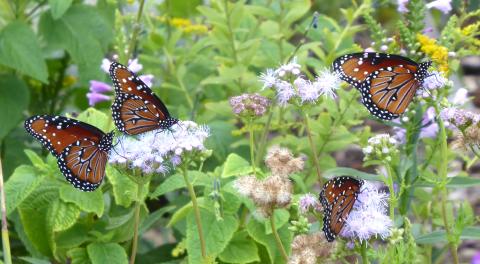 another year of butterfly observations. The past two years, I’ve written about butterflies and moths I’ve observed. For those GardenNotes, Local Butterflies, and Local Butterflies 2021, I based my observations on the photos I had taken, conveniently date stamped. (Quartet of Queens on Gregg's mistflower at left.)
another year of butterfly observations. The past two years, I’ve written about butterflies and moths I’ve observed. For those GardenNotes, Local Butterflies, and Local Butterflies 2021, I based my observations on the photos I had taken, conveniently date stamped. (Quartet of Queens on Gregg's mistflower at left.)
At the beginning of last year, I decided to take notes as well as photos to document my sightings. Most butterflies and moths included here were documented by a photo, the best I could obtain given their skittish nature on our many windy days. My steadfast observation regime rewarded me with a few rare sightings, such as an Eastern tiger swallowtail in May and one giant swallowtail at the end of June, and a number of others only briefly showing up later in September and October. Butterfly/moth species recorded in the tables below were from our home garden in Southwest Amarillo.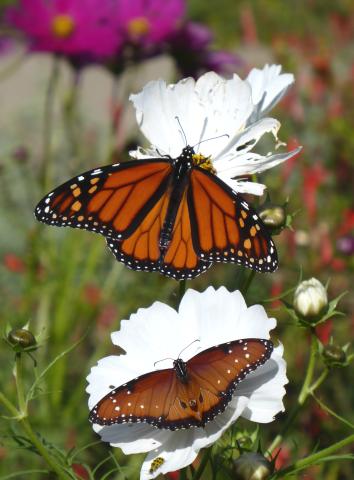
During the first months of observations, my quest was to record the medium to larger sized butterflies, thoughtlessly ignoring the small common butterflies such as Reakirts blue, gray hairstreak, common sootywing, skippers and sulphurs. Finally, by September, I could not ignore their presence, and shouldn’t have. Still, it seemed there were decreased populations in 2022 feeding on the low growing early flowering sedums, Salvia nemorosa Profusion and Marvel hybrids May through July that attracted so many in years past. (Photo at right shows a monarch top, queen, below both on white cosmos. When seen together, it is easy to see the difference.)
My interest in Lepidoptera lies mainly with the butterflies. I was undecided about recording moths, not near as colorful, and many not flying during the day. I did record some moths during the daytime, none at night. Most common were the sphinx and clearwing moths. However I did note a few other species. Many whitish and grayish moths began appearing in mid-October. Moth counts are included in the Monthly Summary, below.
Nearly every day from late April into October, the pesky common cabbage white butterfly could be seen, from a single butterfly to half a dozen, especially when young brassica plants were set out. I stopped recording them daily; they were as reliably present as were flowers and leaves until the first hard freeze On November 4th. Cabbage whites were entirely excluded from the butterfly count. (Painted lady at left on Verbena bonariensis.)
General Observations
The winter of 2021-2022 was a relatively dry winter across Texas, as was the spring of 2022. Trips to Palo Duro Canyon confirmed many perennials flowered sparsely or remained dormant until a few summer rains in June. But by that time, it was too late for spring blooming plants to flower.
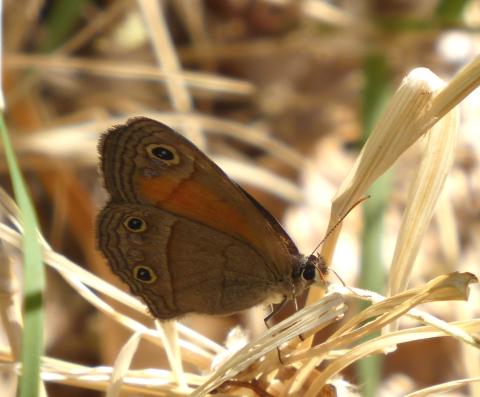
Without nectar plants, few butterflies can make the trip from the Texas Gulf Coast to Amarillo. My husband and I made two trips to Palo Duro Canyon, once in May and once in June, but only saw one common buckeye on June 28th and very few flowers scattered throughout the Park during our visits. (Photo at right.)
I observed surprisingly few butterfly species and number of species in our garden in May through August. Multiple times a day, each day, would be spent looking for butterflies, and finding few to none (save the cabbage white). I surmise it took a few reproduction cycles until the numbers were great enough to reach the Texas Panhandle, aided by summer rain and flowers.
My practice is not to capture butterflies to tag or measure or keep; however, as an amateur observer, it seemed to me the smaller butterflies were smaller than usual. Even the first wave of painted lady butterflies seem unusually smaller than in other years, although I noted the same smaller size last year. Butterfly larvae do have the ability to grow smaller or larger sizes before pupating, depending on availability of food sources (Adaptive Growth Decisions in Butterflies). Perhaps this is a case of pupate now, or never. In my research on these butterfly species, there were several references to differing adult sizes season to season, and at differing times during the season.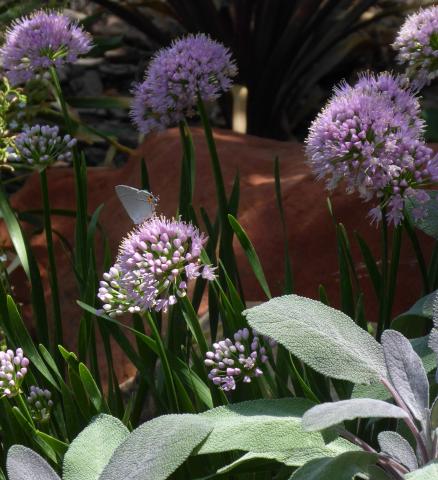
From late spring and summer, Amarillo experienced another hot summer season with decreased average rainfall and a windier first half of the summer season. Verbena bonariensis flowers were available by May, many of them flowering continuously into early fall, as were the sedums and salvias mentioned above. The first blooms by Gregg’s mistflower, Conoclinium greggii, was ready by the time the first Queens arrived on June 15th. My echinaceas and rudbeckias did not return after caterpillars of the silvery checkerspot devoured them last year. To supplement them, I added cosmos, a butterfly favorite, that came strongly into bloom after Labor Day, which all the larger butterflies seemed to favor over Verbena bonariensis by then. I’m thinking the verbena’s nectar production declined after four months.

June through August I recorded one to two species each day, and almost always only one or two of each species. With the exception of the smaller Reakirts blue, gray hairstreak, common sootywing, skippers and sulphurs, there is a lapse of records until near the end of August. I did note a good population the week of June 10th - 25th . (Gray Hairstreak on Allium at left. Reakirts blue on verbena at right.)
After Labor Day, the butterflies returned, both in number of species and numbers per species. Queen butterflies were the most common butterfly to be observed (see chart at end of Specific Observations). I was even able to photograph a pair of Queens mating on September 9th and on October 15th.
For most of the month of September, butterflies were skittish, flitting from flower to flower, making it difficult to photograph, but by the end of September and through to the first frost, much of the darting activity slowed. They became single minded on feeding, a pattern I noticed in other autumns.
The date of the first freeze occurred on November 4th, allowing roughly an extra two weeks over the average date of first freeze, lengthening the growing season. The flowers held up well, feeding the influx of butterflies of all sizes. During the last six weeks of the butterfly season, all butterflies became less selective – nearly any flower would do for nectar. Flowers that begged for butterflies for much of the summer bore nectar for 3 or more at a time. It was quite a feeding frenzy to observe.
|
|
May
|
June
|
July
|
August
|
September
|
October
|
November
|
|
|
|
|
|
|
|
|
|
|
Avg Species per Observation Day
|
1
|
1-4
|
1-2
|
1-2
|
5
|
6.25
|
4.3
|
|
|
|
|
|
|
|
|
|
|
Avg No per Species/day
|
|
|
|
|
|
|
|
|
Medium and Large Butterflies
|
1
|
>1
|
1-2
|
1
|
5.5
|
12
|
7.5
|
|
Small Butterflies and Moths
|
None
|
Some
|
1
|
>1
|
Many
|
Many
|
Some
|
|
|
|
|
|
|
|
|
|
Specific Observations
 My method for recording observations was to make several observations a day, as I enjoy being outside, or at least in the shade of the porch most afternoons during the heat of the summer. I recorded the highest number of any one species per day that I was able to count at one time, not a compilation during the day. For example, if at eleven o’clock, I saw two queens, then later at noon, one; at one o'clock, 3 queens, and at 4, 4 queens, then the number recorded was four for the day. Counts definitely varied from hour to hour, with the most butterfly activity between the hours of 11 o’clock and four. And by dusk, all but the sphinx moths (on occasion) could be seen.
My method for recording observations was to make several observations a day, as I enjoy being outside, or at least in the shade of the porch most afternoons during the heat of the summer. I recorded the highest number of any one species per day that I was able to count at one time, not a compilation during the day. For example, if at eleven o’clock, I saw two queens, then later at noon, one; at one o'clock, 3 queens, and at 4, 4 queens, then the number recorded was four for the day. Counts definitely varied from hour to hour, with the most butterfly activity between the hours of 11 o’clock and four. And by dusk, all but the sphinx moths (on occasion) could be seen.
Each butterfly is interesting in their own right. The longer one observes, the more one notes. Here are a few remarks for each of the butterfly and moth species noted in order of first appearance to our garden, as well as a table at the end listing butterflies in order of most seen and seen most often.
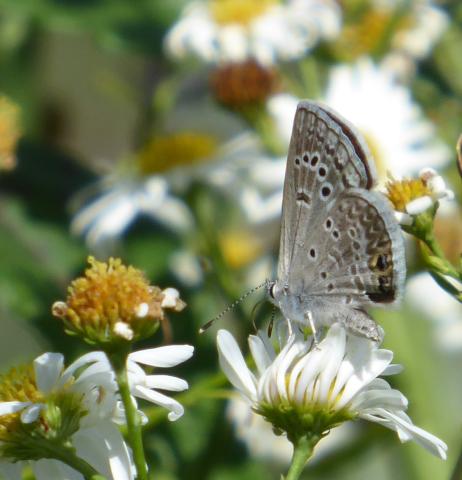
Eastern Black Swallowtail, Papilio polyxenes. The first notation for butterflies observed is the black swallowtail on May 8th. In years past, many visited our garden. But last year I observed it only 6 days spread across the season. Finally, it dawned on me. I failed to plant parsley and, apparently, had few other plants it liked. It searched, and moved on. Black swallowtails prefer plants and herbs of the carrot family, such as parsley, caraway, rue, celery, dill and fennel as host plants. Note to self and butterfly gardeners, planting butterfly host plants is helpful. (Black swallowtail at left on purple Salvia greggii.)
The swallowtail genus of butterflies must have been highly regarded, as the genus name "Papilio" is the Latin word for butterfly. They are colorful and one of the largest of the North American butterflies.
Eastern Tiger Swallowtail, Papilio glaucus. I recorded observing the eastern tiger swallowtail on May 9th, but wasn’t able to get a photo. I am confidant in my identification as overall yellow with black stripes and tails, and larger that the male black swallowtail, even though it is off its territory somewhat. Nonetheless, it’s always a delight to see one even once, as I hadn’t seen one previously in our garden. No doubt I probably missed other single butterflies as they briefly set down to refresh on a flower before continuing their journey onwards.
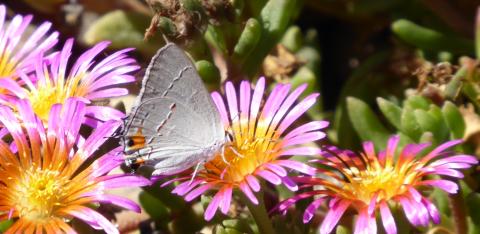 Gray Hairstreak, Strymon melinus, and Reakirt’s Blue, Echinargus isola, are two small butterflies under an inch and a half that were first noticed on June 10th through the 21st. Then no notations until September. Their populations do come and go, however, I am at a loss to say whether I simply failed to look for them or if they weren’t there. I expect their numbers were small during this intermission. In the South, these two butterflies are active year around. I have never seen the gray hairstreak with it’s wings lying flat; they are always held upright, giving an upside-down appearance.
Gray Hairstreak, Strymon melinus, and Reakirt’s Blue, Echinargus isola, are two small butterflies under an inch and a half that were first noticed on June 10th through the 21st. Then no notations until September. Their populations do come and go, however, I am at a loss to say whether I simply failed to look for them or if they weren’t there. I expect their numbers were small during this intermission. In the South, these two butterflies are active year around. I have never seen the gray hairstreak with it’s wings lying flat; they are always held upright, giving an upside-down appearance.
These two small butterflies were 7th and 5th on the list of frequently seen. All of a sudden, by the third week in September, they were both so numerous I gave up counting and noted “many”, which was well over 25 – 50 throughout the garden, perching on all the small flowers previously avoided until this time. It was common to see three to five per one flower, especially autumn flowering sedums. (Gray hairstreak on Ocean Glow Orange iceplant at left and Reakirts blue on Boltonia at right.)
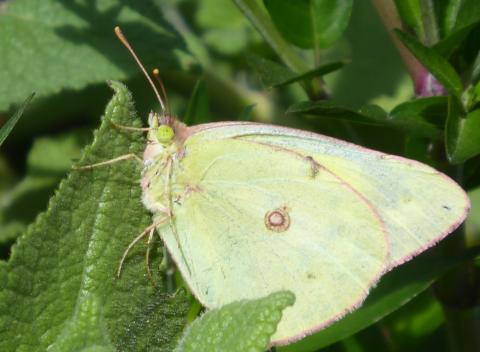
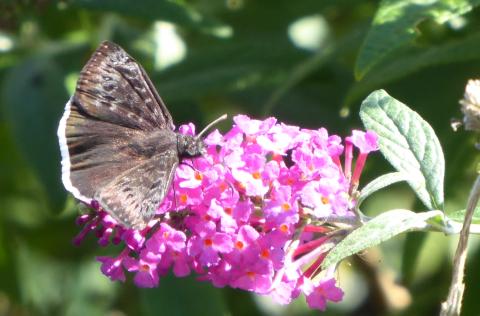 Common Sootywing, Pholisora catullus. Seen, too, and recorded during this same period, another small butterfly with a slightly larger wingspan to 1 5/16th. It appears quite black under certain light angles, and is a pleasant enough little fellow. Common sootywing is 12th, seeing them on 10% of the days. Although I suspect they could have been found more often with better recording practices. (Common sootywing on rose colored Buddleia at left.)
Common Sootywing, Pholisora catullus. Seen, too, and recorded during this same period, another small butterfly with a slightly larger wingspan to 1 5/16th. It appears quite black under certain light angles, and is a pleasant enough little fellow. Common sootywing is 12th, seeing them on 10% of the days. Although I suspect they could have been found more often with better recording practices. (Common sootywing on rose colored Buddleia at left.)
Clouded Sulphur, Colias philodice, also known as the common sulphur (also spelled in some references as sulfur). Light yellow in color, its wingspan reaches 2 ¾ inches. Nearly always the wings are held upright when resting (ventral view), making it difficult to see the dorsal side (wings seen from the top). From the ventral, wings held upright view, the margins along fore and hind wings have a dark outline. One sighting mid June, then not again until nearly the end of September. Clouded sulphurs were 10th on the list of most observed, usually seeing several at a time. (Look closely to see the darker margins of the clouded sulphur in profile on leaf at right. If you ever see the wings open, darker margins are very clear to see.)
Queen, Danaus gili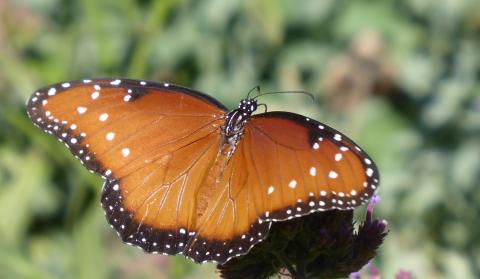 ppus. Queen butterflies were king and queen of the count, observed 75% of the time! (Excluding cabbage whites.) Out of a total of 108 observation days, at least one queen was observed 81 days with a total maximum number observed of
ppus. Queen butterflies were king and queen of the count, observed 75% of the time! (Excluding cabbage whites.) Out of a total of 108 observation days, at least one queen was observed 81 days with a total maximum number observed of 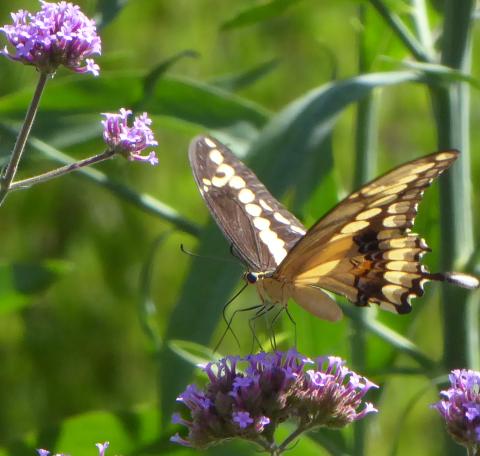 515 queen butterflies. That number is staggering for my small patch of Gregg’s mistflower. For nearly 20 days, 10 or more queens were observed each day, with the highest numbering thirty! Now, that was fun!
515 queen butterflies. That number is staggering for my small patch of Gregg’s mistflower. For nearly 20 days, 10 or more queens were observed each day, with the highest numbering thirty! Now, that was fun!
The queen’s most beloved plant is Gregg’s mistflower, Conoclinium greggii. A two – three foot tall perennial with divided light tri-lobed green leaves, native to Texas, New Mexico and into Arizona. By June, it shows small, purplish-blue flowers cluster together to form puffy, 2 in., cushion-like flower heads. The bloom of the mistflower contains a special alkaloid that male Queens ingest, sequester, and later release as an aphrodisiac to attract females. After visiting blue mist flowers, male Queens can exhibit a bit of the soaring and swooping behavior as the swallowtail butterflies. (Native Plant Society of Texas) If you want to see queens, male or female, look no further than a stand of Gregg’s mistflower. The larger your stand of Gregg’s mistflower, the more queens you will attract. (Full wingspread female Queen butterfly at left.)
Giant swallowtail, Papilio cresphontes. The biggest surprise was on June 25th, a single swooping sighting of the giant swallowtail over my car as I was driving out. Naturally, I drove back in, got my camera and photographed this giant of a butterfly, indeed, as it is the largest of the North American butterflies. I can confirm it was a thrill to see a butterfly so large, averaging from 4 inches to over 6 1/2 inches in width for the male. This one was closer to the 6 1/2 inch size. When I returned, of course, the giant swallowtail was gone for the summer, a brief stop on its way.
The T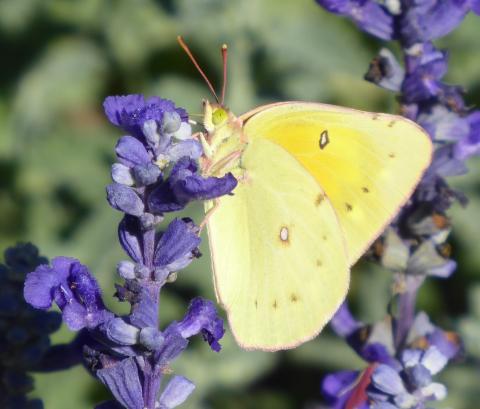 exas Panhandle is within its natural range, though rarely seen, and not listed on our regional checklist. Host plants include trees and herbs of the citrus family, Rutaceae, including citrus species, prickly ash, Zanthoxylum americanum, hop tree, Ptelea trifoliata, and Common Rue, Ruta graveolens. Photo at right does not do justice to it's size, on Verbena bonariensis.
exas Panhandle is within its natural range, though rarely seen, and not listed on our regional checklist. Host plants include trees and herbs of the citrus family, Rutaceae, including citrus species, prickly ash, Zanthoxylum americanum, hop tree, Ptelea trifoliata, and Common Rue, Ruta graveolens. Photo at right does not do justice to it's size, on Verbena bonariensis.
Cloudless Sulphur, Phoebis sennae. Another of the migratory butterflies, was first observed July 2, heading north, most likely. Though I’ve never seen a migration in progress, they travel 2 – 3 feet above ground, rather than high in the air, making it easier to see. Males are clear yellow, while females deep yellow to light with a dark spots on its margin, and a dark spot in the center of the forewing. They are on the large size for a sulphur, 2 to over 3 inches for its wingspan. Cloudless sulphurs appeared often from Labor Day on, about a third of the time overall, and fourth most observed butterfly. I’ve noticed the cloudless sulphur to be the more common of the sulphurs in our area. Most seen in a day were “many” – over 7, on October 31st. 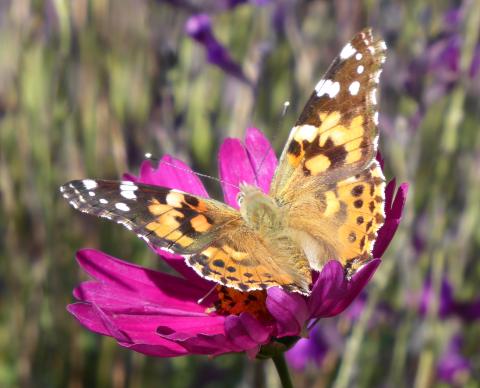
Painted Lady, Vanessa cardui. First spotted July 10th, and 14th, then not again for a month, after which they were regular visitors to my garden. The painted lady was the second most observed butterfly visited in our garden, seen exactly 50% of the time, 54 days out of 108, 193 counted in all. I witnessed greater numbers from October 10th through the end of the month, 14 seen on October 20th alone.
Painted ladies are sometimes called the Thistle butterfly, as are the Vanessa species as a group, because they prefer thistles as a nectar source. The painted lady is also called the Cosmopolite, because of its world-wide distribution, in fact, the most widespread of butterflies found on every continent except for Antartica, though rarely in Australia.
ladies are sometimes called the Thistle butterfly, as are the Vanessa species as a group, because they prefer thistles as a nectar source. The painted lady is also called the Cosmopolite, because of its world-wide distribution, in fact, the most widespread of butterflies found on every continent except for Antartica, though rarely in Australia.
Painted ladies, another migrating butterfly, are known for varying their populations from year to year. I would count this a good year. (Painted lady at right on rose colored cosmos.)
Silvery Checkerspots, Chlosyne nycteis. Seen only once on July 10th, I missed seeing this delightful, small brush-footed butterfly, despite the fact it ate our plants (its caterpillars demolished our echinaceas and rudbeckias last summer). Obviously, I had little to offer in 2022, save one smallish coneflower, which it ignored. (Photo of silvery checkerspot at left is from 2021.)
Variegated Fritillary, Euptoieta claudia. With just two sightings before Labor Day, I noted variegated fritillaries 27% of the days during the season, coming in eighth on the list of frequency. After Labor Day, it was common to see from one to 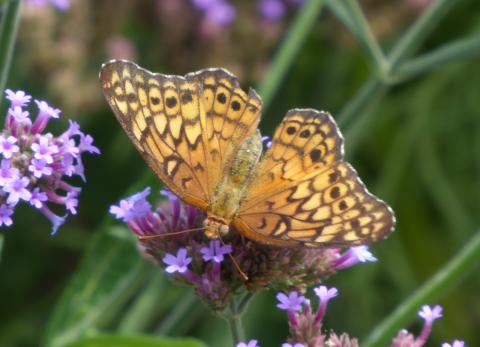 five any day in the garden. The variegated fritillary is a medium size butterfly that boasts an attractive chrysalis described as “luminescent bluish-white dotted with gold, orange and black markings.” Their host plants include Passiflora incarnata, may apple, violets, purslane, sedums/stonecrops, and moonseed. The only hosts plants from this list in our garden are the sedums, which I have quite a few. I will be checking them this coming season for their chysalis. (Variegated fritillary on verbena at right.)
five any day in the garden. The variegated fritillary is a medium size butterfly that boasts an attractive chrysalis described as “luminescent bluish-white dotted with gold, orange and black markings.” Their host plants include Passiflora incarnata, may apple, violets, purslane, sedums/stonecrops, and moonseed. The only hosts plants from this list in our garden are the sedums, which I have quite a few. I will be checking them this coming season for their chysalis. (Variegated fritillary on verbena at right.)
Monarch, Danaus plex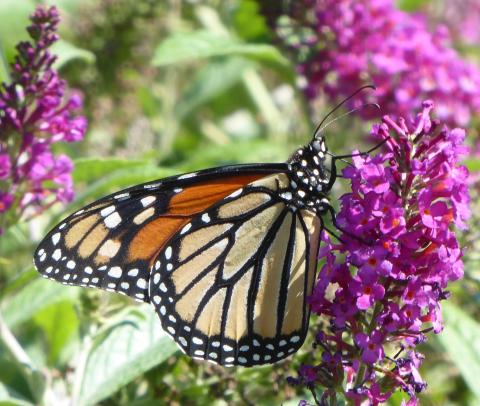 ippus. Although I saw a Monarch at the Amarillo Botanical Gardens on April 26th, I did not include it in this count of butterflies at home. I rarely see a monarch on its northward spring migration. My first garden sighting was on August 5th, then not again until August 31st when they were present nearly every day after to November 6th. Monarchs are third on my list of frequency at 47 days, a 44% visiting rate overall. It is also third in numbers, at 76 monarchs seen throughout the season. Some years, during the southern migration in September or October, over a dozen could be seen sipping nectar at one time. This year, the most per day was 5, and only once on October 15th. Usually one, maybe two, per day. Not a bad year, but not outstanding either, and always exciting to see one.
ippus. Although I saw a Monarch at the Amarillo Botanical Gardens on April 26th, I did not include it in this count of butterflies at home. I rarely see a monarch on its northward spring migration. My first garden sighting was on August 5th, then not again until August 31st when they were present nearly every day after to November 6th. Monarchs are third on my list of frequency at 47 days, a 44% visiting rate overall. It is also third in numbers, at 76 monarchs seen throughout the season. Some years, during the southern migration in September or October, over a dozen could be seen sipping nectar at one time. This year, the most per day was 5, and only once on October 15th. Usually one, maybe two, per day. Not a bad year, but not outstanding either, and always exciting to see one.
On July 21, 2022, the International Union for Conservation of Nature and Natural Resources (ICUN) added the migratory monarch to the IUCN Red List of Threatened SpeciesTM as Endangered, threatened by habitat destruction and climate change. Having been placed on the Red List does not put in place any protections for the monarchs. In 2020, U.S. Fish and Wildlife Service announced that although the agency found that the monarch butterfly qualifies for federal protection under the act, other species (161) had higher priority for their funds, but would continue to reevaluate monarchs each year and make a determination by the end of fiscal year 2024. Perhaps this new Red List designation will add weight to the U.S. Fish and Wildlife Service study. It can’t come too soon.
The host plant of the monarch butterfly are species in the Asclepsia genus. Species of milkweeds are the sole host plants for monarch caterpillars. It is best to plant native milkweed species wherever you live. Because of the attention given to monarchs and milkweeds in the past decade or so, many gardeners rush to plant any milkweed species available. In many cases, what is offered is a tropical milkweed, Asclepias curassavica, that has abundant foliage and flowers.
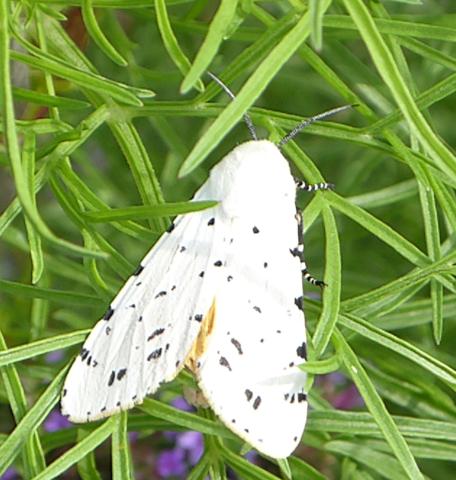 The Xerces Society offers a recommendation: “Tropical milkweed can also interfere with monarch migration and reproduction. When grown in northern areas {such as the Texas Panhandle for this tropical plant}, where it can grow later in the year than native species, the presence of tropical milkweed may confuse monarchs into breeding at a time when they should be migrating.” One solution for our area gardeners, Xerces Society advises, is to remove the plants in late summer so as not to interfere with migration. (Monarch photo ar left on pink butterfly bush.)
The Xerces Society offers a recommendation: “Tropical milkweed can also interfere with monarch migration and reproduction. When grown in northern areas {such as the Texas Panhandle for this tropical plant}, where it can grow later in the year than native species, the presence of tropical milkweed may confuse monarchs into breeding at a time when they should be migrating.” One solution for our area gardeners, Xerces Society advises, is to remove the plants in late summer so as not to interfere with migration. (Monarch photo ar left on pink butterfly bush.)
White-lined Sphinx or Hawk Moth, Hyles lineata. I first spotted one on August 31st, then on seven other occasions in September, a total count of nine sphinx moths, thirteenth most frequently seen. It seems to me the frequency and population was quite low, compared to other years. I pay good a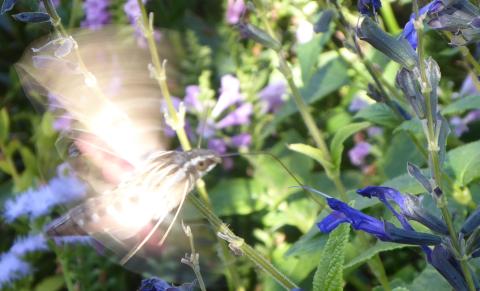 ttention, as I was daily on the lookout for our pair of hummingbirds. I consider them ours, as they feed off our flowers, usually Salvia darcyii. S. greggii, S. guaranitica, and Anisacanthus quadrifidus var. wrightii, even though I’ve never found their nest. I reference this because many people mistake the white-lined hawk moth for a hummingbird. It is one of only four groups of animals that have developed the ability to hover while they sip nectar, the others being actual hummingbirds, hoverflies, and some bats. White-lined sphinx moths sip nectar on a large number of garden plants, particularly tubular flowers of Salvia greggii. (Photo at left shows the hovering action of the white-lined sphinx moth on Salvia guaranitica 'Black and Blue'.)
ttention, as I was daily on the lookout for our pair of hummingbirds. I consider them ours, as they feed off our flowers, usually Salvia darcyii. S. greggii, S. guaranitica, and Anisacanthus quadrifidus var. wrightii, even though I’ve never found their nest. I reference this because many people mistake the white-lined hawk moth for a hummingbird. It is one of only four groups of animals that have developed the ability to hover while they sip nectar, the others being actual hummingbirds, hoverflies, and some bats. White-lined sphinx moths sip nectar on a large number of garden plants, particularly tubular flowers of Salvia greggii. (Photo at left shows the hovering action of the white-lined sphinx moth on Salvia guaranitica 'Black and Blue'.)
Salt Marsh Moth (Acrea Moth), Estigmene acrea. The salt marsh moth enjoys a wide territory across the United States. I first saw one on August 2 while checking the rain gauge that morning. It was hanging from a cosmos leaf, quite noticeable – bright white with black dots – against light green fern-life foliage. I later moved it to a rock for a better examination. Medium in size, its head and thorax are bright white. The abdomen is orange-yellow with black spots; tip of abdomen is white on females. It’s forewing is white with variable black spots and the hindwing dark orange-yellow in males, white in females, with 3-4 black blotches in both sexes. The legs are striped black and white. I was excited to see a moth so different from the usual dull small gray moths until I read its larvae devours many crop vegetables including asparagus, bean, beet, cabbage, carrot, celery, corn, lettuce, onion, pea, tomato, turnip, and probably others. Field crops damaged are alfalfa, clover, cotton, soybean, sugarbeet, and tobacco. The salt marsh moth has at least five instar stages that can really decimate crops. I saw one a second time on September 3, and hope that is the last time. (Photo at right.)
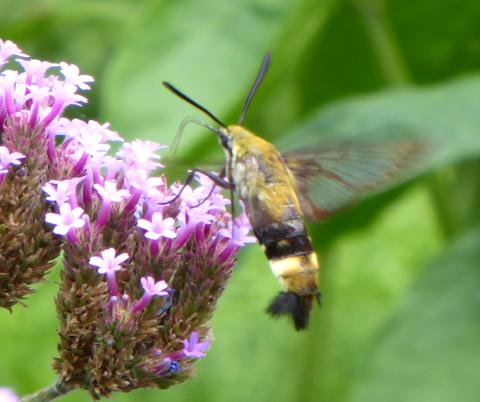
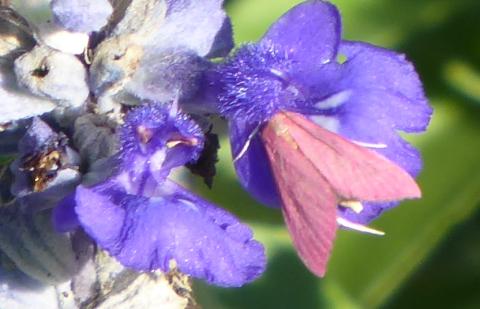 Southern Pink Moth, Pyrausta inornatalis. The southern pink moth is a tiny pink moth with a wingspan of about a half inch that I first noticed on September 3 (and a few other times) on Salvia farinacea ‘Victoria Blue’. It's about the size of my pinky fingernail. At first I was excited. But after identifying it, I became disturbed. I went back and looked and found a few more, but only a few. My research informed me that the southern pink moth is a major pest of salvias. Larvae of the southern pink bore into the base of flower buds causing bloom drop. I looked a number of times, but did not notice any of the larvae, but they are small and may have escaped my attention. Its range is normally in the Southern states, including Texas, but has been reported much further north into Oregon in 2020. Cold temperatures below 20° are said to kill the larvae. I’ll be on the lookout for it in the coming year. Click here for more information. (Photo of the tiny Southern pink moth at left on 'Victoria Blue' salvia.)
Southern Pink Moth, Pyrausta inornatalis. The southern pink moth is a tiny pink moth with a wingspan of about a half inch that I first noticed on September 3 (and a few other times) on Salvia farinacea ‘Victoria Blue’. It's about the size of my pinky fingernail. At first I was excited. But after identifying it, I became disturbed. I went back and looked and found a few more, but only a few. My research informed me that the southern pink moth is a major pest of salvias. Larvae of the southern pink bore into the base of flower buds causing bloom drop. I looked a number of times, but did not notice any of the larvae, but they are small and may have escaped my attention. Its range is normally in the Southern states, including Texas, but has been reported much further north into Oregon in 2020. Cold temperatures below 20° are said to kill the larvae. I’ll be on the lookout for it in the coming year. Click here for more information. (Photo of the tiny Southern pink moth at left on 'Victoria Blue' salvia.)
Note on identifying moths and butterflies: When I spotted both the salt marsh and southern pink moths, I did an Internet search with just their descriptions, such as “white moth with black spots”, and “tiny pink moth”. Photos pop up and within minutes I was able to identify them, just as I have with many other butterflies. It only takes a moment.
Snowberry Clear-wing Moth, Hemaris diffinis. Snowberry clearwing looks like a big bumblebee with big clear wings. On occasion it can be confused with the hummingbird moth. It is called a snowberry clearwing because the caterpillars (a hornworm) feeds on snow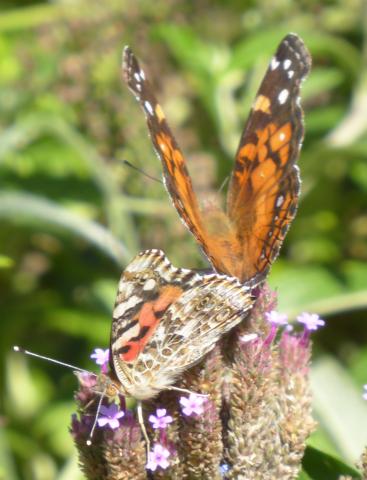 berry, dogbane, honeysuckle, and dwarf bush honeysuckle. I’ve noticed them each year, last year on September 5th and three other days. I think they were around sooner,
berry, dogbane, honeysuckle, and dwarf bush honeysuckle. I’ve noticed them each year, last year on September 5th and three other days. I think they were around sooner, 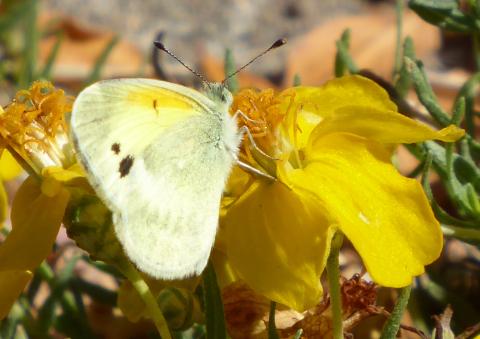 and more often than I noted. Sometimes, when one stands in the garden, camera in hand, one fails to notice all the life buzzing around; but I try. (Photo of snowberry clearwing at right at Verbena bonariensis.)
and more often than I noted. Sometimes, when one stands in the garden, camera in hand, one fails to notice all the life buzzing around; but I try. (Photo of snowberry clearwing at right at Verbena bonariensis.)
Dainty Sulphur, Nathalis iole. September 5th was my first spotting of the dainty sulphur, the smallest of the sulphurs. Dainty sulphurs usually appear in the fall, so it was right on track. It is small, with a wingspan a little over an inch and flies mainly close to the ground. I usually find it on daisy-like flowers close to the ground, but not always. Occasionally I’ll see it up higher on Verbena bonariensis or even the tall cosmos. Dainty sulphurs migrate south for the winter; it being so small, takes until September to reach the Texas Panhandle. I observed it nearly every day until my last sighting was October 14th,. It came in ninth on frequency observed. (Photo of dainty sulphur on prairie zinnia at left.)
Common Checkered Skippers, Burnsius communis, formerly Pyrgus communis. The common checkered skipper is a spread-wing skipper, making them easy to identify. I first noted seeing one on September 14th. They live all year long in the south, making their way north in the summer. It seemed a bit late for seeing them the first time. Even so, the common checkered skipper is sixth on my list of frequency seen, 34 days, nearly a third of the days, many days seeing several. (Photo of common checkered skipper on Ocean Glow orange iceplant left, below.)
Amer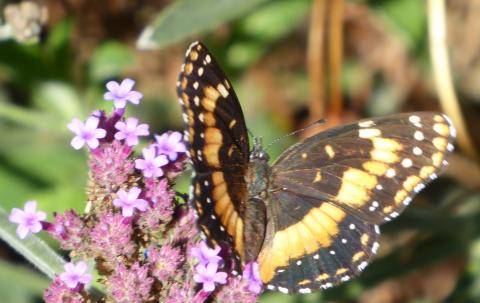 ican lady, Vanessa virginiensis. Throughout the summer and fall I didn’t think an American lady visited our garden. But after reviewing the photos this winter, I saw one photo of an American Lady with the distinc
ican lady, Vanessa virginiensis. Throughout the summer and fall I didn’t think an American lady visited our garden. But after reviewing the photos this winter, I saw one photo of an American Lady with the distinc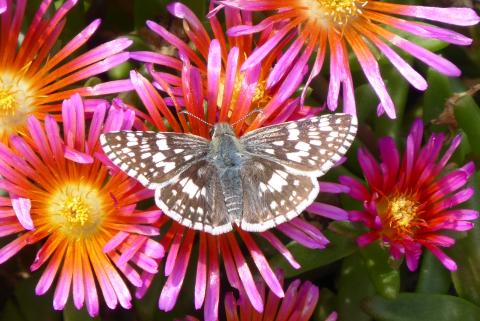 tive white dot in an orange field in its forewing. It’s easy to miss, especially when they flit from flower to flower. When holding their wings upright, look for the two large eyespots and cobweb pattern on the lower wing side. Some years, we’ve had many more visit. Photo at right shows the American lady with a painted lady butterfly below it -- notice the four eyespots on the painted lady.)
tive white dot in an orange field in its forewing. It’s easy to miss, especially when they flit from flower to flower. When holding their wings upright, look for the two large eyespots and cobweb pattern on the lower wing side. Some years, we’ve had many more visit. Photo at right shows the American lady with a painted lady butterfly below it -- notice the four eyespots on the painted lady.)
Bordered Patch, Chlosyne lacinia. Bordered patch is a medium sized brush-footed butterfly up to 2 inches across. It is predominantly brown and black, with a curving band in shades of orange, and white spots on the wingtips, small orange or white postmedian spots, and variable in appearance. It is sometimes called the Sunflower Patch. Teams of caterpillars of the Bordered Patch will skeletonize sunflowers. Indian blanketflower and ragweed are also host plants. I had a lone sighting of bordered patch, even though I plant sunflowers. Photo of bordered patch at left on Verbena bonariensis.
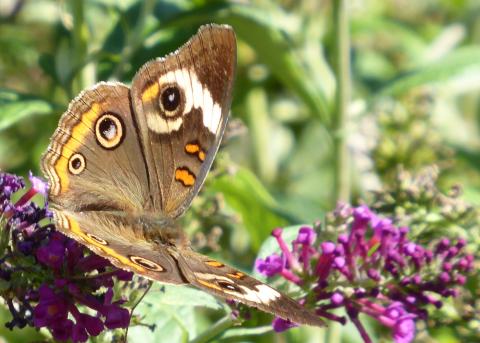 Common Buckeye, Junonia coenia. I had only a single two day sighting of the common buckeye. The common buckeye is a very showy medium size, brush-footed butterfly with a wingspan to 2 ¾ inches. Common buckeyes are mostly brown above with two orange bars on the leading edge of the forewing and an off-white forewing band. All four wings have eye-catching eyespots. Eyespots on butterflies are an interesting adaption. But not a recent adaption. In fact, it dates back millions and millions of years further than previously imagined (more on this later, near the end). Eyespots are thought to mimic eyes of a larger, more threatening animal to ward off predation. (Common buckeye at left with pronounced eyespots.)
Common Buckeye, Junonia coenia. I had only a single two day sighting of the common buckeye. The common buckeye is a very showy medium size, brush-footed butterfly with a wingspan to 2 ¾ inches. Common buckeyes are mostly brown above with two orange bars on the leading edge of the forewing and an off-white forewing band. All four wings have eye-catching eyespots. Eyespots on butterflies are an interesting adaption. But not a recent adaption. In fact, it dates back millions and millions of years further than previously imagined (more on this later, near the end). Eyespots are thought to mimic eyes of a larger, more threatening animal to ward off predation. (Common buckeye at left with pronounced eyespots.)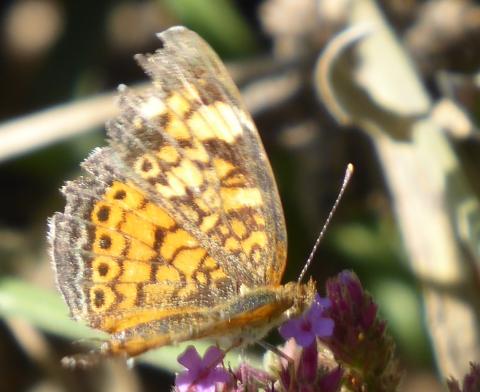
Pearl Crescent, Phyciodes tharos. Pearl crescents have a wide range in North America, except for the West Coast. It is a small brush-footed butterfly. The common name comes from a crescent-shaped, light-colored spot surrounded by a darker patch on the outer edge of the hindwing. In adult pearl crescents, the wing pattern varies, but all have orange wings with black borders with fine black markings. Their coloration is variable both geographically, and from season to season. They fly low to the ground, often in an erratic pattern. Asters are one of their host plants. One butterfly sighted on October 3rd and 4th. (Photo of pearl crescent at right, showing a little bit of wear -- getting on to the end of its life span.)
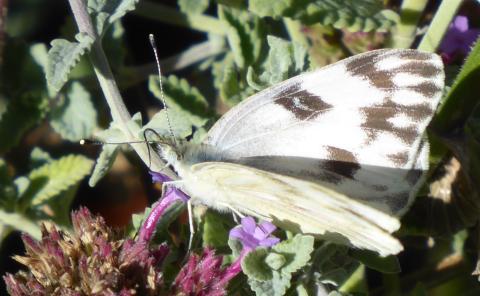 Checkered White, Southern Cabbageworm, Pontia protodice. The checkered white has a wingspread up to 1¾ inches, in early spring and later fall, the adults are smaller. The upperside of the wings are white and marked with black and gray, more so on the female than on the male. The larvae, which is occasionally found on crop plants in the family Brassicaceae, is known as the southern cabbageworm. However, it’s official common name is checkered white. It can be a pest, but doesn’t appear to be as much of a pest as the cabbage white. I only began noticing the checkered white around October 14th, and only for three days. (Photo of checkered white at left on verbena.)
Checkered White, Southern Cabbageworm, Pontia protodice. The checkered white has a wingspread up to 1¾ inches, in early spring and later fall, the adults are smaller. The upperside of the wings are white and marked with black and gray, more so on the female than on the male. The larvae, which is occasionally found on crop plants in the family Brassicaceae, is known as the southern cabbageworm. However, it’s official common name is checkered white. It can be a pest, but doesn’t appear to be as much of a pest as the cabbage white. I only began noticing the checkered white around October 14th, and only for three days. (Photo of checkered white at left on verbena.)
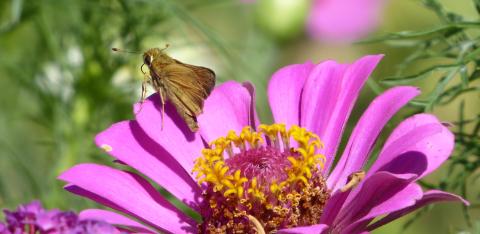
Skippers. Skippers are a large group of butterflies in the family Hesperiidae, that have gotten their common name from their rapid, skipping flight. They are small in size and are different from other butterflies in that their bodies are larger in proportion to their wings and have a hooked bulb at the end of each antenna, bent ninety degrees to the side, rather than straight. There are seven subfamilies of skippers; many North American skippers are grouped in three subfamilies, the grass skippers, flowering plant skippers and giant skippers, which include yucca and agave skippers. (Photo at right, skipper on zinnia.)
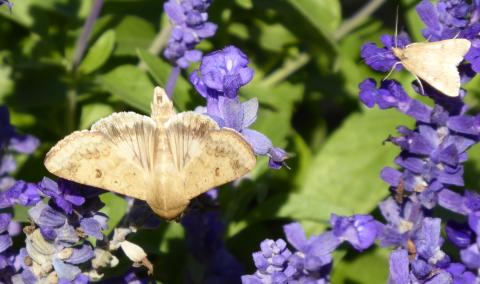 Other than the common sootywing sightings in June, I first noticed other skippers on September 5th. Skippers are a large group of butterflies with over 3500 species globally, and many of them are hard to identify, apparently until they’re dissected. Visually, it is hard for me to identify most of them, as they will look different under differing light conditions, and whether their wings are flat or upright. Having said that, I’ve seen several different ones from year to year. Overall, skippers as a general group came eleventh on my record of frequency seen, usually seeing several each day.
Other than the common sootywing sightings in June, I first noticed other skippers on September 5th. Skippers are a large group of butterflies with over 3500 species globally, and many of them are hard to identify, apparently until they’re dissected. Visually, it is hard for me to identify most of them, as they will look different under differing light conditions, and whether their wings are flat or upright. Having said that, I’ve seen several different ones from year to year. Overall, skippers as a general group came eleventh on my record of frequency seen, usually seeing several each day.
Moths. As mentioned earlier, identifying all the grayish and whitish moths is a challenge for me, as is nocturnal photography. Other than the moths specifically identified and mentioned above, for ten days beginning October 12th, I recorded seeing lots of them each day, then afterward, only once on Nov. 6, which I thought odd.
|
Butterfly/Moth
|
No. Days Butterfly Observed
|
|
Total Number Of Species Observed
|
|
|
|
|
|
|
Queen
|
81
|
|
515
|
|
Painted Lady
|
54
|
|
193
|
|
Monarch
|
47
|
|
76
|
|
Cloudless Sulfur
|
38
|
|
44 and a few days of several*
|
|
Reakirts Blue
|
35
|
|
Many per Observation Day
|
|
Common Checkered Skippers
|
34
|
|
Several per Observation Day
|
|
Gray Hairstreak
|
32
|
|
Many per Observation Day
|
|
Variegated Fritillary
|
29
|
|
46
|
|
Dainty Sulphur
|
16
|
|
Several per Observation Day
|
|
Clouded Suphur
|
16
|
|
Several to Many per day Observed
|
|
Skippers
|
13
|
|
Several per Observation Day
|
|
Common Sootywing
|
11
|
|
Several per Observation Day
|
|
White-lined Sphinx Moth
|
8
|
|
9
|
|
Black Swallowtail
|
6
|
|
6
|
|
Clear Wing Moth
|
4
|
|
4
|
|
Checkered White
|
3
|
|
Some per Observation Day
|
|
Eastern Tiger Swallowtail
|
1
|
|
2
|
|
Salt Marsh Moth
|
2
|
|
2
|
|
Southern Pink Moth
|
2
|
|
Several per Observation Day
|
|
American Lady
|
2
|
|
2
|
|
Common Buckeye
|
2
|
|
2
|
|
Pearl Crescent
|
2
|
|
2
|
|
Giant Swallowtail
|
1
|
|
1
|
|
Silver Checkerspot
|
1
|
|
1
|
|
Bordered Patch
|
1
|
|
1
|
*When marked “several” or “many”, the numbers were too large to count throughout the garden at one time.
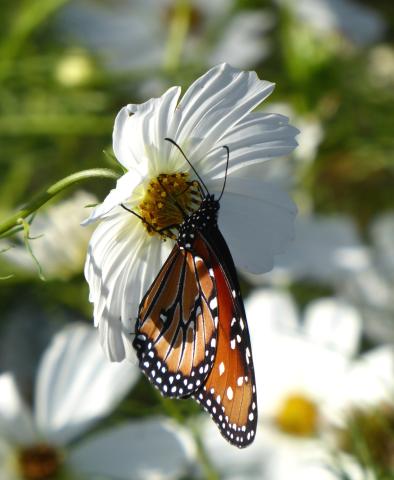 In the two previous GardenNotes, Local Butterflies, and Local Butterflies 2021, I concentrated a good deal on the plants butterflies need as host and nectar plants. Even though I offer nectar to roving butterflies from mid-May on, September and October are the two biggest butterfly months. I’ve tried a number of plants over the years for low-growing border plants. This year, I planted a few of the newer iceplant hybrids and some larger portulaca. Butterflies ignored the iceplants until mid September, when they suddenly became very attractive to them. Rarely did I see a bee or butterfly on the portulacas, though they flowered prolifically all summer and fall. I like my plants to be more than pretty, so I’ll try perhaps more fall blooming sedums, perhaps iceplants and coreopsis. I’ve noticed the last several years, lantanas didn’t attract butterflies much until fall. Is it the new hybrids? I’ll give them another try.
In the two previous GardenNotes, Local Butterflies, and Local Butterflies 2021, I concentrated a good deal on the plants butterflies need as host and nectar plants. Even though I offer nectar to roving butterflies from mid-May on, September and October are the two biggest butterfly months. I’ve tried a number of plants over the years for low-growing border plants. This year, I planted a few of the newer iceplant hybrids and some larger portulaca. Butterflies ignored the iceplants until mid September, when they suddenly became very attractive to them. Rarely did I see a bee or butterfly on the portulacas, though they flowered prolifically all summer and fall. I like my plants to be more than pretty, so I’ll try perhaps more fall blooming sedums, perhaps iceplants and coreopsis. I’ve noticed the last several years, lantanas didn’t attract butterflies much until fall. Is it the new hybrids? I’ll give them another try.
Instead of Rudbeckia and coneflower, I planted cosmos. I was pleased with the numbers of butterflies that enjoyed them in last fall, so I definitely will be planting them again. (Queen on white cosmos at left.)
Native Plants for Butterflies 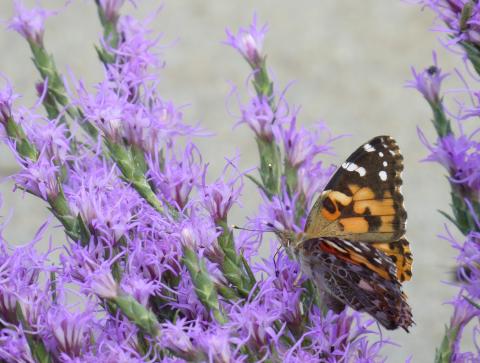
In previous years where we’ve had more winter and spring moisture, native plants in Palo Duro Canyon State Park attract hordes of butterflies in the spring. Horse mint (spotted bee balm), Monarda punctata; star thistle (basket flower), Centaurea americana; Purple coneflower (Black Sampson), Echinacea angustifolia; wavy wax thistle (grey thistle), Cirsium undulatum; blanket flower (Indian blanket, firewheel), gaillardia pulchella; yellow gaillardia (red dome blanketflower), Gaillardia pinnatifida; ; blackfoot daisy (plains blackfoot), Melampodium leucanthum; antelope horn milkweed, Asclepias asperula; fleabane daisy, Erigeron modestus; greenthread (threadleaf Thelesperma), Thelesperma filifolium; Engelmann Daisy (cutleaf daisy), Engelmannia peristenia, Plains yellow daisy (Plains btterweed), Tetraneuris scaposa; spiny daisy (spiny aster cut leaf ironplant), Machaeranthera pinnatifida; and tansy aster (Tahoka daisy), Machaeranthera tanacetifolia among others attract butterflies. (Photo of painted lady on gayfeather, Liatris punctata, a fall blooming native, at right.)
Granted, some of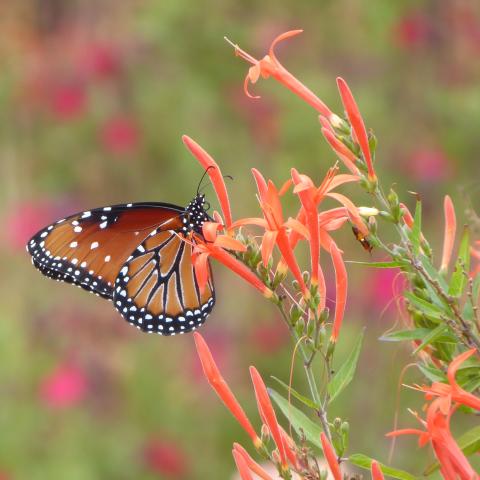 these plants are hard to find, however we in Amarillo are fortunate to have two local nurseries that specialize in native and drought tolerant plants for our area. Canyon’s Edge Plants in Canyon, TX offers a butterfly bundle of plants, and Neal Hinders has posted his list of 2023 plants. Chaparral Cactus and Succulents also carries native or regional plants that attract or host butterflies.
these plants are hard to find, however we in Amarillo are fortunate to have two local nurseries that specialize in native and drought tolerant plants for our area. Canyon’s Edge Plants in Canyon, TX offers a butterfly bundle of plants, and Neal Hinders has posted his list of 2023 plants. Chaparral Cactus and Succulents also carries native or regional plants that attract or host butterflies.
The best source for seeds is Plants of the Southwest, with a large selection of natives from the plains and Southwest. They also offer a mix for a Plains butterfly meadow. American Meadows sells seed mixes and seed packets of flowers for butterflies. High Country Gardens, mail order, offers a wide array of butterfly plants, and a preplanned butterfly garden sampler. They identify their plants as suitable for butterflies, bees, hummingbirds, pollinators, etc., as they apply. High Country Gardens is the Southwest’s best mail order supplier of regionally appropriate plants I’ve seen and used. (Photo of queen on Anisacanthus).
As far as most host plants, if there are particular butterflies you wish to attract, Lady Bird Johnson Wildflower Center offers a special data collection of more than 350 plants that feed and/or host moths and butte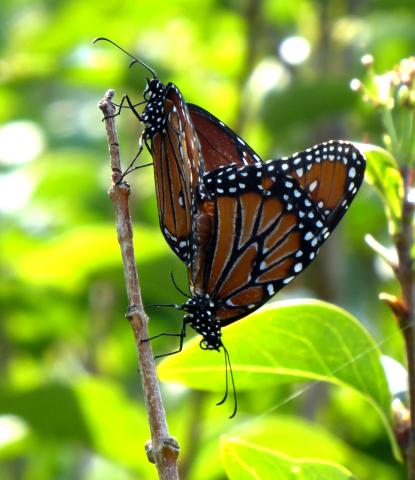 rflies in North America. The Butterfly Identification site is a good beginning point. Often, descriptions of individual butterflies will mention host plants. Expect most (but not all!) of these plants to be native plants.
rflies in North America. The Butterfly Identification site is a good beginning point. Often, descriptions of individual butterflies will mention host plants. Expect most (but not all!) of these plants to be native plants.
Will Butterflies Adapt?
News of how climate change is affecting the weather comes every week, whether extremes about heat or cold, rain or drought across the globe. Our Homo sapiens species now number over 8 billion. More people means more undisturbed land disturbed, leaving less and less natural space for other species, both plant and animal.
Added to the climate crisis, there is now a the biodiversity crisis. The biodiversity crisis is both about loss of species, and declining numbers of individual species.
The past meeting of The Intergovernmental Science-Policy Platform on Biodiversity and Ecosystem Services (IPBES), in Paris in 2019, saw the launch of the Global Assessment Report on Biodiversity and Ecosystem Services, which alerted the world to the fact that a million species of plants and animals now face extinction – many within decades.
According to a study in the journal Nature in March, 2011, “Biologists now suggest that a sixth mass extinction may be under way, given the known species losses over the past few centuries and millennia.” Only five times in the past 540 million years has life on Earth suffered a mass extinction, defined as losing 75% of the population of living species within a short time period (consider short compared to Earth’s life span). With every mass extinction, large numbers of genera and species disappeared, and after time (millions or many millions of years later), new families, genera and species evolved. (Photo of Queen butterflies mating at right.)
New Butterfly Timeline
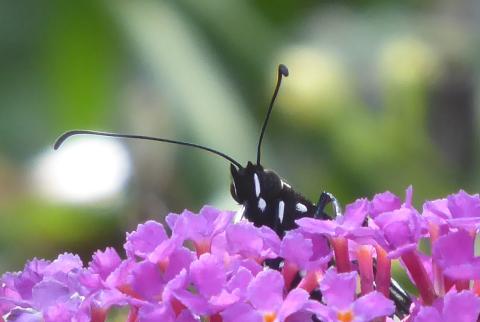 New research has brought to light some startling information of butterflies and moths first appearance. In the geologic time scale, it has now been discovered that butterflies and moths lived during the Triassic period, from 200 to 250 million years ago, roughly tens of millions of years before the first flowering plants, challenging the long held belief that butterflies and moths developed along with flowering plants (angiosperms). A reexamination of a deep core sample in Germany showed flecks along with the usual pollen and spores. Previously, scientists concentrated on examining pollen and spores, but one sample contained an unusual abundance of flecks from a core sample taken 300 feet down dating back to 201 million years ago, at the boundary of the Triassic/Jurassic period of dinosaurs. (Photo of Monarch head at butterfly bush at left.)
New research has brought to light some startling information of butterflies and moths first appearance. In the geologic time scale, it has now been discovered that butterflies and moths lived during the Triassic period, from 200 to 250 million years ago, roughly tens of millions of years before the first flowering plants, challenging the long held belief that butterflies and moths developed along with flowering plants (angiosperms). A reexamination of a deep core sample in Germany showed flecks along with the usual pollen and spores. Previously, scientists concentrated on examining pollen and spores, but one sample contained an unusual abundance of flecks from a core sample taken 300 feet down dating back to 201 million years ago, at the boundary of the Triassic/Jurassic period of dinosaurs. (Photo of Monarch head at butterfly bush at left.)
Evolutionary biologist Timo van Eldijk and his co-authors reported their finding in Science Advances as the earliest fossil record of Lepidoptera, the insect order that includes butterflies and moths. They identified the flecks “as the wing scales that give butterflies and moths their spectacularly varied colors and patterns. A light microscope, and later a scanning electron microscope, revealed the scales to be petal-like structures. Some were beautifully preserved and had neat ridges interspersed with herringbone webbing as well as “micro-ribs” and, in some cases, perforated surfaces.”
“Those perforations turned out to be a critical detail. They indicate, according to the co-authors, a moth of that period had the hollow wing scales characteristic of Glossata, the taxonomic group that includes all modern moths and butterflies equipped with a sucking proboscis. The oldest previously known such fossil was from 129 million years ago—just as flowering plants were making their spectacular emergence around the planet. The accepted theory up to now has been that the sucking proboscis only emerged at that point as a product of coevolution between flowers and the insects that pollinate them.”(Scientific American, Richard Conniff, January, 2018.) 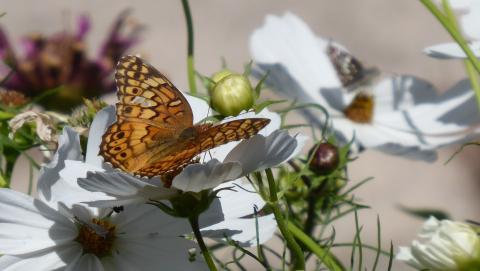
Further researchers had discovered “microscopically small clues such as the fossilized remains of food and pollen trapped in the mouthparts of the insects,” from which they determined these ancient ancestors of butterflies and moths, “fed upon bennettitales using a long tongue to probe nectar deep within the plant. The insects also possessed hairy legs that allowed for carrying pollen from the male flower-like reproductive organs of one plant to the flower-like female reproductive organs of another. . . An extinct order of seed plants called bennettales, these plants first appeared about 250 million years ago during the Triassic period, surviving for nearly 200 million years until the end of the late Cretaceous period.”
“Eventually, this system of pollination by long-tongued lacewings traveling between plants with exposed reproductive parts -- called gymnosperms -- gave way to more familiar system of insect pollinators and modern flowers, or angiosperms, in which the reproductive parts of the plants are contained with a protective seed.” (Science Daily, Feb. 2016.)
Additionally, paleobotanist Dilcher explains: “Poor preservation of lacewing fossils had always stymied attempts to conduct a detailed morphological and ecological examination of the kalligrammatid. “Upon examining these new fossils, however, we've unraveled a surprisingly wide array of physical and ecological similarities between the fossil species and modern butterflies, which shared a common ancestor 320 million years ago. ‘”
“The species are an example of convergent evolution, Dilcher explains, where two distantly related animals develop similar characteristics independently.” (Science Daily, Feb. 2016.)
On a similar note, a recent discovery of a fossilized flower, Florigerminis jurassica, in Mongolia, has been dated to the Jurassic period, roughly 164 million years ago. it was previously thought that flowering plants didn't develop until the Cretaceous period, between 66 and and 145 million years ago. This had definitely caused a re-thinking about the development of flowering plants. It is always possible that even older flower fossils will be discovered.
Eyespots
 These new fossils discovered in Northeastern China reveal an evolutionary coincidence with a group of Kalligrammatid lacewings who share a resemblance to modern-day butterflies. Fossil fragments were examined using using light microscopy, scanning electron microscopy, electron dispersion microscopy and time-of-flight–secondary ion mass spectrometry. Extinct for more than 50 million years before modern butterflies first appeared, “they possess the same wing shape and pigment hues, wing spots and eyespots, body scales, long proboscides, and similar feeding styles as butterflies.” (Proceedings of the Royal Society, Feb., 2016.)
These new fossils discovered in Northeastern China reveal an evolutionary coincidence with a group of Kalligrammatid lacewings who share a resemblance to modern-day butterflies. Fossil fragments were examined using using light microscopy, scanning electron microscopy, electron dispersion microscopy and time-of-flight–secondary ion mass spectrometry. Extinct for more than 50 million years before modern butterflies first appeared, “they possess the same wing shape and pigment hues, wing spots and eyespots, body scales, long proboscides, and similar feeding styles as butterflies.” (Proceedings of the Royal Society, Feb., 2016.) 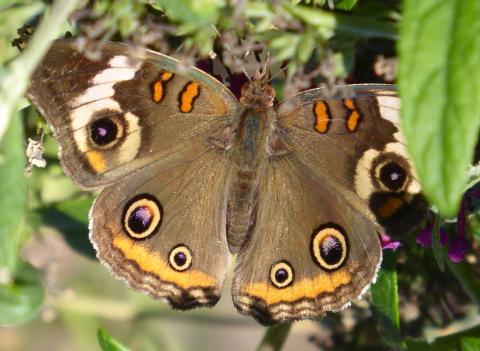
Dilcher again explains: “However, another evolutionary innovation found in the ancient lacewing fossils' wings remained remarkably unchanged over the course of millennia: so-called "eye spots." (Photos of the common buckeye at right and enlarged eyespots at left.)
This unique pattern on the wings, arising over 200 million years ago, is nearly identical to markings on the modern owl butterfly. To this day, owl butterflies use these circular marks as a defense mechanism against predators, which mistake the spots as the eyes of a larger, more threatening animal. (Science Daily, Feb. 2016.)
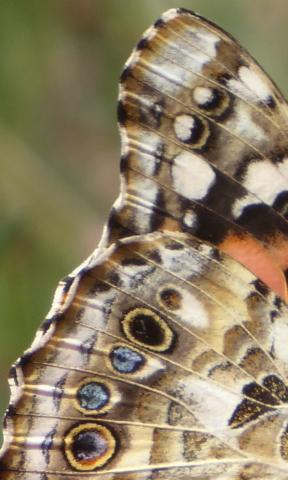
The report from the Royal Proceedings continued: “Kalligrammatid mouthparts—resembling a long flexible, straw-like proboscis—evolved from the chewing mandibles of their ancestors, the different parts of which were conjoined to form a long tube. . . . “That tube is basically used to feed on surface fluids; in the case of butterflies, it is used for angiosperm nectar, to accomplish pollination,” Labandeira says. “Kalligrammatids fed upon gymnosperms which had weird reproductive structures that included elongate tubes, channels, funnels and other tubular structures.”
“In one fossil the scientists were able to examine elements contained in an opaque piece of “gunk” found stuck inside the food tube of a kalligrammatid proboscis. The enriched carbon reading of the mass was consistent with a nectar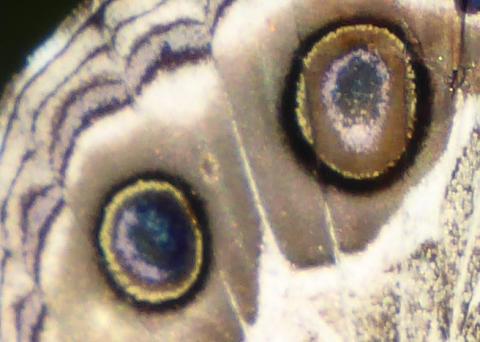 -like fluid. Elemental analysis was also able to determine the likely presence of the substance melanin in kalligrammatid wing eyespots. Melanin is a common pigment in butterfly eyespots. (Photo at left of Painted lady eyespots, and American lady eyespots at right.)
-like fluid. Elemental analysis was also able to determine the likely presence of the substance melanin in kalligrammatid wing eyespots. Melanin is a common pigment in butterfly eyespots. (Photo at left of Painted lady eyespots, and American lady eyespots at right.)
The extinct kalligrammatid is called Oregramma illecebrosa. “Another genus of this insect — of the order Neuroptera — survives into our modern era, and are commonly known as fishflies, owlflies or snakeflies. Pictures and photos of the ancient lacewing and modern owlflies shows the evolutionary convergence of mid-Mesozoic lacewings and Cenozoic butterflies and the first known appearance of eyespots. (World Fossil Society) At the top of the Smithsonian Insider article are photos of the extinct lacewing Kalligrammatid and the owlwing butterfly, looking not too unlike the common buckeye.
This research shows that butterflies, or at least, butterfly relatives, survived both the Triassic-Jurassic extinction 201 million years ago, as well as the Cretaceous-Paleogene (K-Pg) extinction 66 million years ago. These extinctions were long before the entrance of Homo sapiens.
The most recent epoch is called the Holocene, dating back 11,700 years ago, concluding with the last glacial retreat.
Very recently, a new name has been given to our current epoch, the Anthropocene. The Anthropocene denotes the present geological time interval, in which many conditions and processes on Earth are profoundly altered by human impact. This impact has intensified significantly since the onset of industrialization, taking us out of the Earth System state typical of the Holocene Epoch that post-dates the last glaciation. (Anthropocene.info) Not everyone agrees that human activity warrants the naming of a new epoch on the geologic time scale. However, Homo sapiens are making a case for it.
In the last five years, studies in Germany revealed a 76% decline in flying insect biomass at several of Germany's protected areas over 30 years, and another in Puerto Rican rainforests reported losses of between 98% and 78% for ground-foraging and canopy-dwelling arthropods over a 36-year period.
“The above studies, however, are in line with previous reports on population declines among numerous insect taxa (i.e. butterflies, ground beetles, ladybirds, dragonflies, stoneflies and wild bees) in Europe and North America over the past decades. It appears that insect declines are substantially greater than those observed in birds or plants over the same time periods (Thomas et al., 2004), and this could trigger wide-ranging cascading effects within several of the world's ecosystems.” (Biological Conservation.)
So, news that in our epoch, the Holocene/Anthropocene epoch, another mass extinction could occur should grab our attention. It is well understood that we are indeed in a biodiversity crisis, if not the sixth extinction.
Will enough of our beloved butterflies adapt enough and quickly enough to survive? Optimistically, they are apparently hardier that what they look. Insects have certainly held their own under pretty substantial life disturbances; not all species surviving by any means, but enough to continue on to evolve new species over time.
If we are in a sixth extinction, you and I probably won’t be around long enough to definitively say so. But the trends are there. As it is said the sixth extinction is caused by human impact, it is solely up to us humans to try to forestall it.
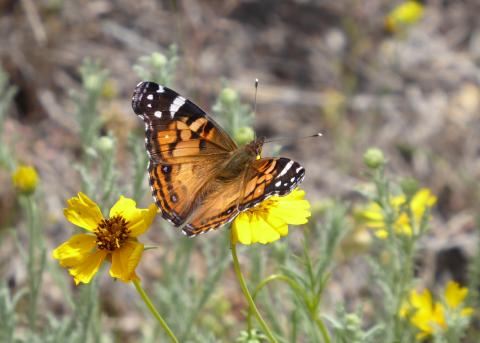
Join me in planting for our pollinators! I want to share the joy of seeing these creatures in our natural world as long as possible. If more and more people across Amarillo and the Texas Panhandle plant for butterflies, the overall number of butterfly and butterfly species might hold, or at least slow the decline. This will allow all of us more time with the butterflies, and your grandchildren and great grandchildren to enjoy them as well. If not, it may be millions of years again in the future before they return in the numbers enjoyed only a decades years ago. (American lady on threadleaf thelesperma in Palo Duro Canyon from 2019.)
Resources
Adaptive Growth Decisions in Butterflies, Karl Gotthard, BioScience, Volume 58, Issue 3, March 2008.
Biological Conservation. Worldwide decline of the entomofauna: A review of its drivers, April 2019.
Butterflies and Moths of North America, Regional checklist.
Geological Society Publications, A Jurassic Flower Bud from China, Jan., 2022.
ICUN, Migratory monarch butterfly now Endangered - IUCN Red List, July 21, 2022.
Local Butterflies, HighPlainsGardening.com.
Local Butterflies 2021, HighPlainsGardening.com.
Nature, Has the Earth’s sixth mass extinction already arrived? Antony Barnosky, etal, March, 2011.
Oregon Department of Agriculture Fact Sheet, Pest Alert: Southern Pink Moth, Pyrausta inornatalis, Jan. 2021.
Proceedings of the Royal Society, Feb., 2016.
Science Advances, “A Triassic-Jurassic window into the evolution of Lepidoptera”, by
Timo J. B. van Eldijk etal., January, 2018.
Scientific American, Richard Conniff, January, 2018.
Science Daily, Feb. 2016.
Smithsonian Insider, “Remarkable butterfly look-alike lived 50 million years before butterflies appeared,” John Barrat, February, 2016.
World Fossil Society, “Oregramma illecebrosa: Discovery of ‘Jurassic butterflies’”, February, 2016.
Angie Hanna, February, 8, 2023